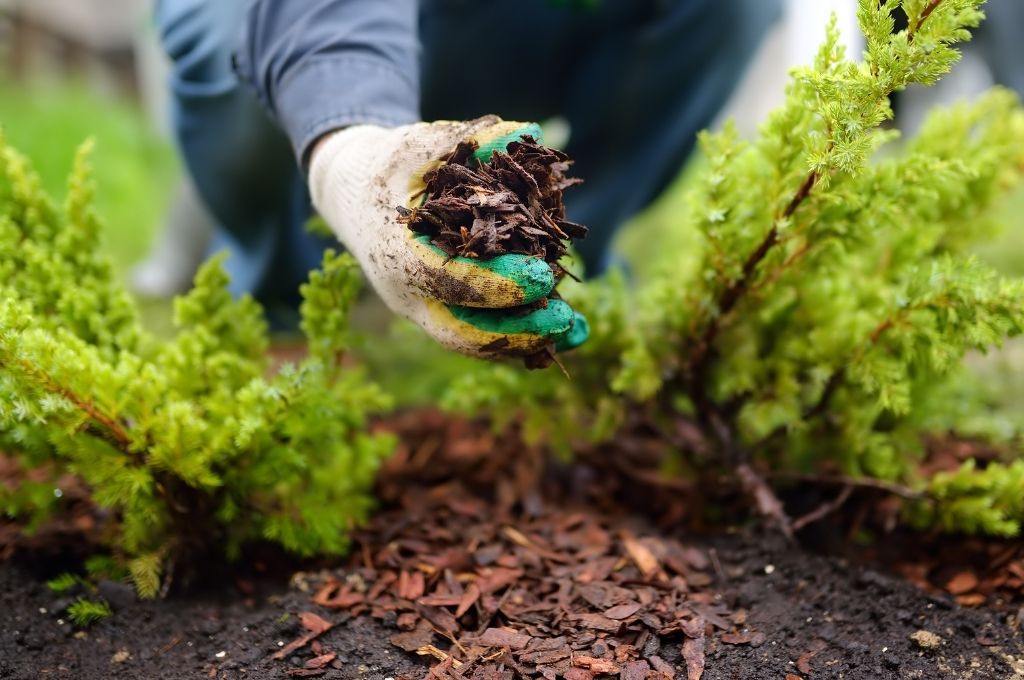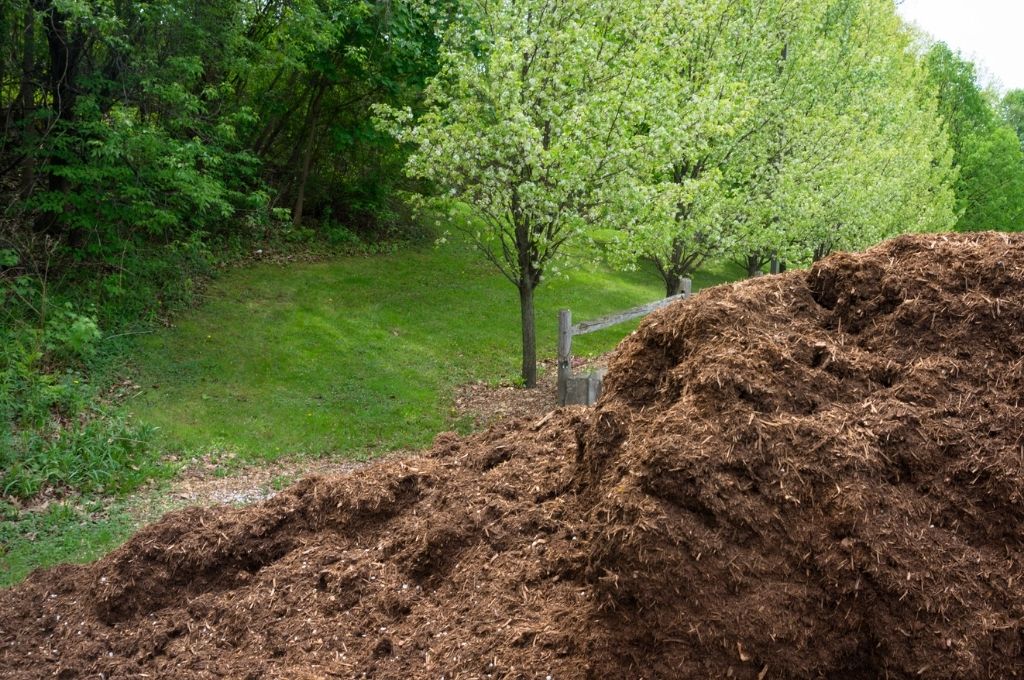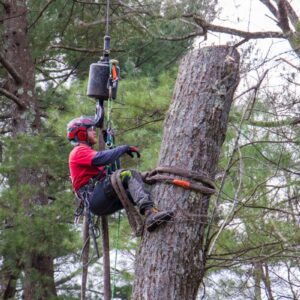Mulch is an important part of keeping your trees healthy, warm, and hydrated, especially during the Massachusetts winter. But when it’s used incorrectly, mulch can kill your trees. In this article, we cover:
- the benefits of using organic mulch on your property,
- why mulch can harm trees, and
- how to correctly apply organic mulch to help your trees (without setting the neighborhood on fire!).
Benefits of Mulch
Putting mulch around your trees and shrubs pays dividends all year round by protecting and insulating the soil and suppressing weeds. Whether you have a new garden or mature trees, mulching should be part of your garden maintenance. There’s no bad time to add mulch!
How Mulch Helps Trees in Every Season
Winter
In winter, a thick layer of mulch over your trees’ roots will insulate and protect them from both freezing ice and dry, bare soil when snow doesn’t fall. Winter weather can be cold and very dry, and while your trees are dormant, their roots never stop taking up water and nutrients.
By insulating with mulch, you both protect roots and slow water evaporation from your soil. The insulation also keeps soil temperature consistent, even when we get an unexpected warm period in winter. The consistently cool soil means trees and shrubs won’t break dormancy only to be slammed with frigid temperatures a few days later.
That layer of mulch will also lessen the chance of winter freeze-thaw cycles that heave soil (sometimes pushing plants right out of the ground), unbalance trees, and expose tree roots.
Spring
At the start of spring, place mulch around your trees to suppress the weeds that jump up as soon as the weather warms. Garden weeds compete with your trees for water and soil nutrients, so keeping them under control helps your trees (and reduces the time you spend weeding!). Plus, fewer weeds means less herbicide use.
Mulching your trees in spring will also keep soil cooler during spring heatwaves. Your trees are using a lot of energy and water to push out new leaves and flower buds so they’ll appreciate the cooler soil.
Summer
During our hot summers, applying mulch will insulate your soil, and protect delicate tree roots from heat and water stress. A layer of mulch slows the evaporation of soil moisture, which will help prevent summer water stress.
Autumn
Mulching is a key part of fall clean-up and winter preparation, as a thick layer of mulch will keep your garden looking tidy after leaves fall and summer flowers fade. After you rake up debris, ready your garden for winter dormancy or late-season hot weather by spreading organic mulch over tree roots.
This is especially important if you’re planting new trees in late fall, as they need protection from cold, heat, and dryness to limit transplant shock.
How Organic Mulch Helps Your Landscape
When we say mulch, we mean organic mulch, such as ground up or chipped wood, and green waste such as leaves and twigs. While there are many types of mulch, organic wood mulch makes use of green waste that would otherwise go to landfills, and it has the added benefit of long-term soil improvement. So, even if you don’t have trees or large shrubs, using mulch can give you a healthier and more beautiful landscape.
Mulch Adds Soil Nutrients
As wood mulch breaks down, its organic matter becomes part of the soil. Tiny particles of nutrients bond to the soil, improving soil structure and fertility. Healthy soil with plenty of organic matter supports vigorous tree growth and holds more moisture for longer.
Granular or liquid fertilizers are useful when your trees need an immediate dose of nutrients, but these types of fertilizers don’t improve your soil’s long-term health.
Mulch Protects the Soil
Another important benefit of mulch is protecting the soil. You won’t find bare soil in forests or woodlands because fallen leaves, twigs, and branches create a natural mulch layer that continuously breaks down and cycles nutrients back into the soil.
In your garden, organic mulch will protect your soil from both erosion and compaction. When your soil surface is bare, heavy rainfall compacts it, making a crust that prevents water from soaking in. Similarly, rainfall and irrigation spray will erode bare soil and wash off topsoil.
How to Mulch Around Your Trees & Shrubs
When you mulch your trees and shrubs, there are two things you want to get right:
- Mulch layer depth, and
- Mulch location.
How Thick to Spread Mulch
You should apply mulch (and maintain it) in a layer that’s a minimum of three inches thick.
You need enough mulch to block sunlight from reaching the soil and germinating weed seeds. This same mulch thickness also insulates the soil beneath it from extreme temperatures and keeps the soil moist.
Where to Place Mulch Around Your Trees
There are two parts to this:
- how close you place mulch to the tree trunk and
- how far you spread it around the tree.
The most important thing is to keep mulch away from your trees’ trunks.
Don’t make mulch volcanoes! When you pile up mulch around a tree’s trunk, it holds moisture against the tree’s bark, creating conditions for fungal decay and insect infestation. Mulch volcanoes kill trees.
Burying a tree’s root flare (with soil or with mulch) also increases the likelihood that your tree will develop girdling roots which will slowly strangle your tree to death.
The best way to mulch around your trees is to taper down your mulch thickness as you get near your tree’s trunk.
How Often to Replace Mulch
Over time, organic mulch will shift, compress, and break down. Check your mulch layer and replenish it annually or whenever you see it thinning. A load of mulch doesn’t cost much in relation to the benefits it gives your garden!
Where to Get Mulch
Whether or not you spread mulch yourself depends on the size of your garden and how much time you have.
If you have a small yard or only want to place mulch around a few trees, you can buy a wide range of bagged wood mulch at local garden centers and home improvement stores. It’s convenient, easy to transport (no mess in your car!), and fairly easy to carry into the garden and dump where you need it.
For a larger yard, it’s much less expensive to have mulch delivered loose, in bulk, instead of in individual bags, but you’ll receive a big pile at your curb. While mulch isn’t heavy, shoveling, pushing a full wheelbarrow, and raking mulch around your trees and shrubs is hard work, especially in a large garden. That’s where you may want to hire a landscape company to do the work for you.
PRO TIP: If you’re having a tree removed, we may be able to leave the wood chips behind to use as mulch. Just be aware that it’ll be a LARGE pile, we may not be able to leave it exactly where you’d like (it depends on access for our equipment), and it won’t be tidy. If that’s ok with you, just let us know!
Beware of Flaming Mulch!
Because organic mulch is made from chipped wood and other tree debris, it can be flammable when dry.
While our summers generally have regular rainstorms, sometimes we have extended periods of hot, dry weather (here’s how you can help trees affected by heatwaves). Dry weather combined with fire starters, such as burning cigarette butts tossed into mulch, can mean combustion.
DID YOU KNOW? The state of Massachusetts has regulations on mulch and mulch fire safety!, Visit their website for helpful tips on how to prevent mulch fires.
While single-family homes and buildings with six units or less are exempt from the state’s law, it’s worth following the sensible advice on the Massachusetts state website regardless of the size of your home. Use organic mulch in your garden for its benefits and natural look but stop your mulched planting beds before they reach your house.
Maintaining an 18” strip of non-flammable mulch (such as crushed rock, gravel, or pebbles) around the outside of your house is a sound preventive measure, as it helps ensure that a spreading fire won’t find fuel close to your home.
In Summary
If you’re not already using organic mulch around your trees and shrubs, there’s no time like the present to get started! Regardless of the season, trees (and your entire landscape) will benefit from a layer of wood chips, shredded wood or bark, shredded leaves, or other organic mulch covering their roots.
Blog Topics
Recent Posts
What's Happening? Stay Informed!
Stay on top of local events, pest and disease updates, tree and landscape tips, and more. Delivered straight to your inbox each month.










